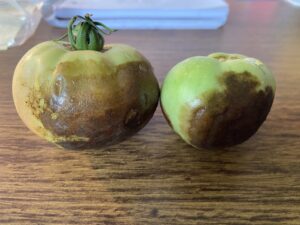Tomato Troubles: Brown Spots on Tomato Fruit
go.ncsu.edu/readext?946965
en Español / em Português
El inglés es el idioma de control de esta página. En la medida en que haya algún conflicto entre la traducción al inglés y la traducción, el inglés prevalece.
Al hacer clic en el enlace de traducción se activa un servicio de traducción gratuito para convertir la página al español. Al igual que con cualquier traducción por Internet, la conversión no es sensible al contexto y puede que no traduzca el texto en su significado original. NC State Extension no garantiza la exactitud del texto traducido. Por favor, tenga en cuenta que algunas aplicaciones y/o servicios pueden no funcionar como se espera cuando se traducen.
Português
Inglês é o idioma de controle desta página. Na medida que haja algum conflito entre o texto original em Inglês e a tradução, o Inglês prevalece.
Ao clicar no link de tradução, um serviço gratuito de tradução será ativado para converter a página para o Português. Como em qualquer tradução pela internet, a conversão não é sensivel ao contexto e pode não ocorrer a tradução para o significado orginal. O serviço de Extensão da Carolina do Norte (NC State Extension) não garante a exatidão do texto traduzido. Por favor, observe que algumas funções ou serviços podem não funcionar como esperado após a tradução.
English
English is the controlling language of this page. To the extent there is any conflict between the English text and the translation, English controls.
Clicking on the translation link activates a free translation service to convert the page to Spanish. As with any Internet translation, the conversion is not context-sensitive and may not translate the text to its original meaning. NC State Extension does not guarantee the accuracy of the translated text. Please note that some applications and/or services may not function as expected when translated.
Collapse ▲You’re heading out to the garden to harvest your beautiful, ripe tomatoes, but when you get there, you find fruit that has dark brown spots on the skin. It is common to jump to the very typical problem with tomatoes, blossom end rot. However, there are two other conditions that are copy-cats in their symptoms: Late blight and buckeye fruit rot both cause similar dark spots on the fruit of tomatoes.
With blossom end rot, the dark spotting will occur on the terminal end of the fruit, where the flower once was. If you see spots on the side or top of the fruit, this is a good indication that the fruit is not affected by blossom end rot.
Late blight and buckeye fruit rot differ in several ways. Late blight tends to have noticeable symptoms on the leaves and stems as well as the fruit. Plants affected by buckeye fruit rot may have plants that appear to be perfectly, but with rotting fruit. The lesions on the fruit with buckeye fruit rot will be firm and smooth with concentric rings, like ripples of lighter shades protruding from the spots. Whereas, the spots on fruit with late blight will be rough and will not have these concentric rings. Ultimately, if you still can’t decide based on the symptoms, consult the recent weather patterns. Late blight thrives in cool, wet conditions, and buckeye fruit rot prefers warm, wet conditions.
If you’re still unsure what is ailing your tomatoes, please give your local N.C. Cooperative Extension office a call and discuss the possibility of submitting a sample to the Plant Disease and Insect Clinic at NC State University.




